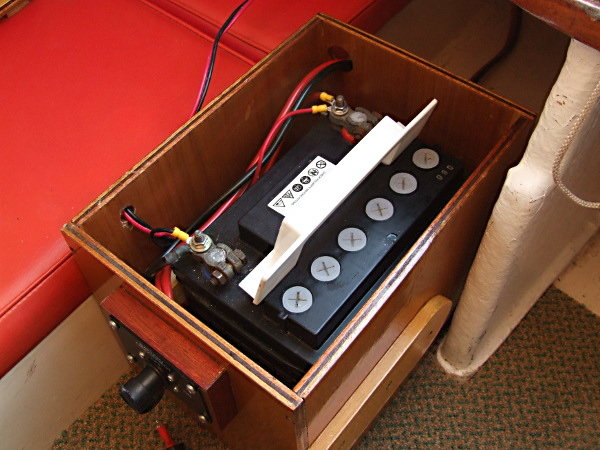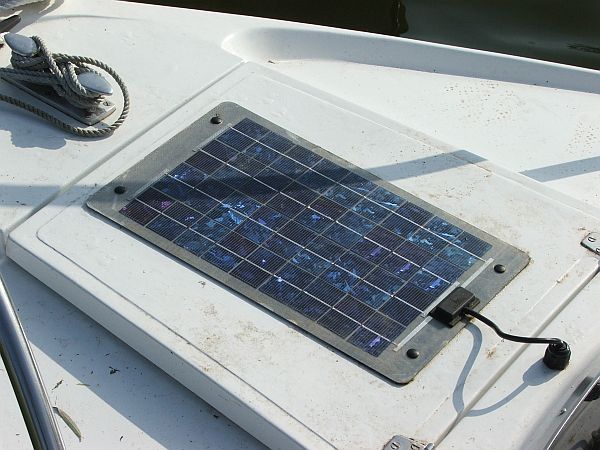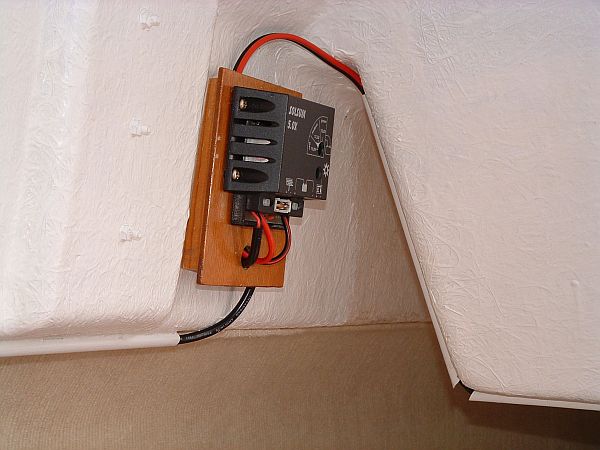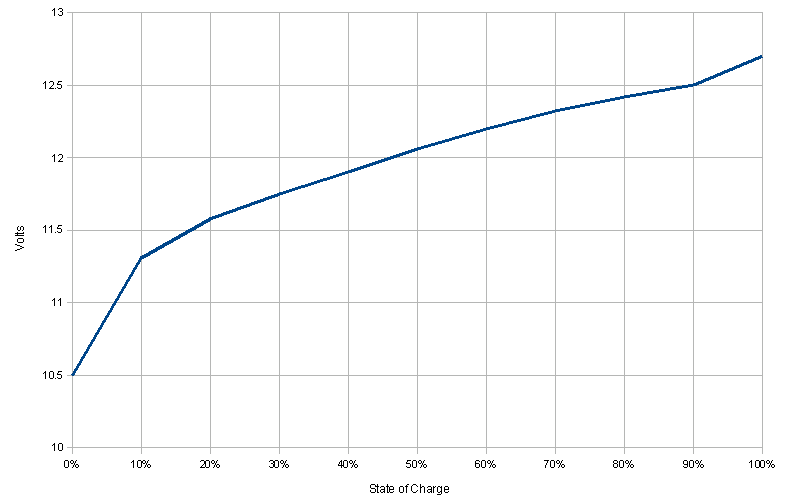Electrickery Questions
|
|
I am about to relaunch my SeaHawk after a major repaint job. I run a Minn Kota 50 outboard powered from a 85amp/hr Leisure Battery:
 and recharged through a Solex 20w solar panel  and Solsum 5.0Xcharge controller  Here's a better view of a similar model.  All the images are from a couple of years ago before adding navigation lights to the system. The power for these are taken from the output terminals on the charge controller (marked with the radio symbol). As I understand it, all this equipment was bought in 1998 when the previous owner of the boat took a mooring at Rutland Water. Petrol engines are banned there. The battery box and cabling is mine. Now for the questions... I have not yet re-connected the solar panel but as the charge controller voltage light was flashing red, indicating low voltage I decided to connect up my 1966 vintage 3amp Halfords battery charger. Before I did this I put a multi-meter across the battery terminals and it showed something near 11 volts - half a volt lower on the charge controller output terminals. I turned on the charger and the voltage levels changed to something over 15 volts, again half a volt lower at the charge control output terminals. Do these readings indicate that the battery is past its prime? Is it time to consider buying a new battery? In my time it's had very little use. I only use the engine to take me 100m out of the dyke where I moor the boat and under Broadland bridges, and it is constantly charged by the solar panel, even in winter. Since the photo of the solar panel was taken the edges of the rubbery top sheet have began to buckle peel away from the surface of the panel. In some places it's now very close to coming away from the actual cells of the panel. When the buckling first started I cut small V-shaped slivers out of the sheet and glued it down again, but this doesn't seem to have been a long term solution. Is there any way to repair this or, again, is it time to consider a new panel?
Greg Chapman
GregAfloat - My Boating Biography |
|
|
If the battery is 13 years old, then it is probably well past its best, but nevertheless may be recovereable to some degree. The 11V at the terminals before you charged it bodes well, as a totally dead battery would probably show a lot lower voltage than this after such a long period of storage. 15V on charge is about right when fully charged, but does indicate that this battery is quite badly sulfated and has a high internal resistance, as this voltage has been measured long before the battery can have reached full charge. Are you able to measure the charge current? If it is low then that's another good indication of sulfation. My advice would be to keep it on charge for a very long time, several days, maybe a few weeks, watching the electrolyte levels carefully. If it starts to gas quite vigorously after a while then that's a good sign that it may be slowly recovering. Getting rid of sulfation is a slow process done at low charge current for long periods of time, with no guarantee of any success, unfortunately.
If it does recover then it's likely that it will have a lower capacity than it did originally, as some damage to the plates will have already occurred. The solar panel is the same type as I have on my electric Winsome roof. It's laminated EVA heat bonded to the aluminium backing. The good news is that the cells are sealed inside the EVA, so even if it does peel away from the aluminium sheet it will still work OK. I'd suggest fitting some thin strip around the edge and adding additional screws to hold it down, with a good bonding sealant like Sikaflex to re-glue the unbonded areas and to seal the strips to the top of the panel edges. I intend to do this to my panels (I have 4 off 50 watt ones, made by Sunflex) as they are already showing slight signs of lifting in places. As a temporary fix I've found that ironing the lifted areas back down, with a fairly hot iron and a layer of smooth paper to stop it sticking to the sole of the iron, seems to work. Jeremy |
|
|
In reply to this post by GregHBBR
Greg,
I concur with Jeremy - the battery is probably the weakest point but if the motor still does its job then I'd hang onto the battery a bit longer. To test the panel: 1) Disconnect the panel from everything, leaving the wires bare. 2) With a multimeter measure the panel voltage in sunshine - its called the open circuit voltage or Voc 3) Then set the multimeter to current - the 10A range if possible 4) Then measure the current through the panel - its called the short circuit current or Isc Now immediatly set the multimeter back to volts. If you leave it on current and decide to measure battery voltage, forgetting it is measuring current, you will instantly blow the fuse in the multimeter which is often buried inside the case - its a pain in the nethers to fix! The small 9" x 9" panel I had on Illusion just measured at Voc 17.5 Volts and Isc 0.2 Amps. I would expect higher current from your panel. Panels degrade up to 1% per year, modern large panels are guarenteed to have 80% output in 20 or 25 years but many early panels have lasted 40 years. So I expect many more useful years from your panel. Digital voltmeter modules are cheap enough on ebay to make a permanent voltmeter on board. They only take a few milliamps but connect via a push button or switch to avoid running down the battery during the Winter. For example: http://www.topsellings.com/en/blue-lcd-digital-volt-meter-voltmeter-p10492.html?language=en¤cy=GBP Fit one of those and you can monitor the battery health accurately. cheers Paul |
|
|
Hi Jeremy and Paul,
Thanks for your input! I'm back home again now and have had a look on the back of my solar panel. It seems it's a 10w, (9.9w) not the 20w model I mentioned earlier.  I tried Paul's Voc and Isc tests in blazing sunshine (surprisingly!) this afternoon. I got 19.0v and 0.28amp. While the Voc is close to the manufacturer's plate, the Isc figure is low although slightly better than the figure Paul gets on his small panel. I failed to get the top surface of the solar panel to stick by ironing it (though the metal stayed hotter than I expected for a while!), so I have resorted to duct tape to seal the edges. The tape matches the metallic grey of the panel well enough, so I think should be acceptable to keep it going for a few more seasons. When I first connected up the Halford's charger, I was surprised to find almost zero current. (In my youth I was taught that the meter on the charger will show high current with a discharged battery and that it would drop as the charge is taken up by the battery.) However, within a few minutes it had risen to just over 1.5 amp on the charger's gauge - that's half its nominal maximum charge. I'm leaving it on charge overnight, but I'm hoping to launch her tomorrow, so that will be all the charge she'll get - other than the solar panel - unless I go to the fag of bringing the battery home for the next few days. Should be sailing her next Sunday at the Hickling Passage Race!
Greg Chapman
GregAfloat - My Boating Biography |
|
|
Greg,
0.28A is probably about right for September assuming the panel was flat - you'll get more if its perpendicular to the Sun at mid-day but that's a mug's game on board. Also 0.28A is enough for a slow charge and to offset normal self-discharging of the battery. Expect around 12.6V after the battery has settled down for 15 minutes after disconnecting from the charger. This chart from Wikipedia shows capacity against voltage:  If it stays above 12V that will be good, as heavy discharge cycles reduce the battery life. cheers Paul |
|
|
In reply to this post by GregHBBR
Greg,
I think you should keep a look-out for the small automatic chargers that Lidl sells at random intervals. (They're not there just at the moment though.) These are very good at re-conditioning old batteries with sulphation problems, and being fully automatic they can be left connected for long periods without damaging the battery. I run a caravan 85AH battery which was stupidly left with a TV aerial amplifier left on for a few months. It was showing zero volts! After starting the auto charger on the 6V setting, the battery came back to life, and then I set it to the 12V frost setting (this was mid winter during the snow and ice) and it eventually charged all the way back up. After cycling the battery a couple of times and leaving it on the "conditioning" trickle charge for a while, it seems to be fully recovered (although probably not full capacity). These chargers are only about £12 or something like that - maybe a little more with the new VAT. Ian |
|
|
Because I hardly use the thing, often paddling out of my mooring, rather than use the motor, and it is kept constantly connected to the solar panel, summer and winter, there's always been power there when I wanted it.
Indeed, the only time it's not been connected to the solar panel, during my ownership, was for another 9 month period in 2005, when I did a similar repaint project. The only other times I've looked inside the battery box is once a year at the beginning of each season to top up the cells. This year, surprisingly, no top up was needed as there was plenty of fluid above the plates. For me, the great advantage of what I've got is that the battery never leaves the boat! I have no shore power at the mooring, and the prospect of having to disconnect the thing and carry it home on a regular basis fills me with dread. The Charge Controller, will both cut-off the charging in the event of over-charge and in the event of excessive drain, should I leave the navigation lights on. Also wired through and protected by the charge controller is a cigar lighter socket I fitted, intended for re-charging my mobile phone, and perhaps, in the future, powering some navigation equipment, should I need to turn to something other than river-side signposts. The Minn Kota outboard is not run through the charge controller but, for security, I always bring it home, so there's no risk of leaving that on by mistake. I was going to say, maybe I should take battery care more seriously, but as it stands, it seems to look after itself pretty well!
Greg Chapman
GregAfloat - My Boating Biography |
«
Return to General Discussion
|
1 view|%1 views
| Free forum by Nabble | Edit this page |

